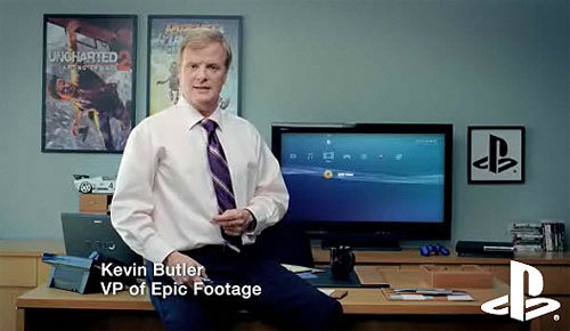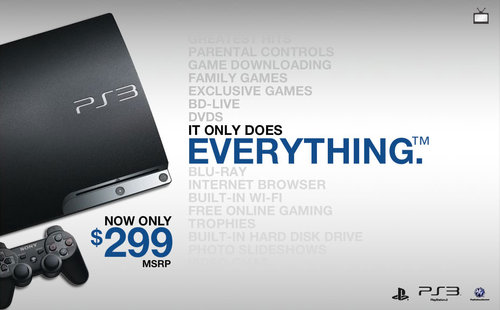INTRODUCTION
The end of 2006 marked the arrival of the PlayStation 3, Sony’s entrance into the next generation of video game consoles. The last generation console war saw the PlayStation 2 as the clear winner with over 150 million units sold worldwide. With this success, Sony appeared to be arrogant and refocused their branding and advertising campaigns.
In order to hype up potential buyers, Sony’s $150 million advertising campaign focused on how “out of this world” the new console is and will be, going as far as creating TV ads that confused rather than informed customers about the benefits of the new console. Sony then began placing the PS3 as a high-end machine, one that would cost $600; making it one of the most expensive game consoles ever released.
At the unveiling of the system, Ken Kutaragi, Sony‘s CEO at time time, exclaimed, “The PS3 is for consumers to think to themselves, ‘I will work more hours to buy one’. We want people to feel that they want it, irrespective of anything else” (Cundy, M, 2007). This ‘holier than thou’ attitude led to people ignore the new system in favour of the cheaper and more readily available Microsoft Xbox 360. The PlayStation 3’s sales suffered and company stock went down. Sony realized that they needed to drastically change their message in order to gain back the audience that they had lost.
Two years later and still feeling the negative effects of their marketing gaffe, Sony unveiled their new “It Only Does Everything” campaign to the delight of consumers and analysts alike. This new campaign focused more on what potential consumers wanted and not what Sony wanted for their consumers. Sony had clear goals: increase market share, fix the PlayStation 3 brand/image, and increase sales of the system and its software lineup. After re-evaluating their failed marketing campaign, Sony refocused their new one, taking advantage of the 7 P’s of marketing: Product or Service, Price, Promotion, Place, Physical Evidence, People, and Process.

PRODUCT AND SERVICE (The PlayStation Brand/Image)
The original PlayStation 3 marketing campaign came out and basically bombarded consumers with advertisements and promotions that had vague product and service specifications. Some of their ads were so creepy, that they were pulled from television because of viewer complaints. Consumers knew that the PlayStation 3 was available, yet they didn’t know what differentiated it from the PlayStation 2 and other game consoles that were out at that time. Sony’s “It Only Does Everything” campaign focused on informing potential consumers of the product and service differentiation of the PS3 and why they should upgrade to the new black box.
Through TV, newspaper, magazine, radio, and online ads, as well as social marketing outlets like Facebook, Twitter, and Youtube, Sony pointed out how their product and services stood out amongst the competition. “From now through the holiday season, you’ll see and hear about all the broad features and benefits this amazing device has to offer across multiple media including TV, radio, online, retail, and social networking outlets. A total of 9 TV spots will roll out throughout the holiday, each highlighting a different benefit and feature of the PS3. So whether you’re a hardore gamer or a Blu-ray enthusiast, you will have something to take away from these ads” (Dille, P. 2009). These TV ads used humour and language that spoke to their audience, all the while informing them of the multiple benefits that they’d get compared to the competitors’ consoles. Now that consumers knew of the features and differentiators of the product, such as product reliability, strong dealer network (in this case the PlayStation Network), and finally, first-and-third-party software support, Sony wanted to let them know of the massive price cut that could potentially send the PS3 into every home in North America.
PRICE (It Only Does $299)
For the first two years of its lifespan, the PlayStation 3 was priced at $600 and considered as the Ferrari of gaming consoles. Everyone wanted one, but only a few could afford it. Of course, Sony will always have their hardcore followers who will buy every new game console they release, however, Sony had been losing much of their user base to the Xbox 360 and the Nintendo Wii; both were competitively priced, had an earlier release date, and had more software that attracted consumers who were ready to upgrade to the next generation of gaming consoles. Fast forward to 2009, Sony announced that it would lower the PS3’s price to a competitive $299 -the same price as Xbox 360 – along with the unveiling of the “It Only Does Everything” campaign. Sony also clarified that their multiplayer online network service, called “PlayStation Network,” was free to use, compared to Microsoft’s Xbox Live service which forced users to pay $59.99 yearly in order to play online. Announcements and advertisements could only take the message so far; Sony needed to handle their promotions differently than before.
PROMOTION AND PEOPLE (The Kevin Butler Effect)
Sony needed something or someone that people would empathize with and understand in order to promote their product and campaign. Sony’s executives were out of the question since they were already infamous for stating their views that tended to alienate their fan base. Thus, Kevin Butler: VP of Everything was born. The fictional Sony spokesperson was the star of the massively successful “It Only Does Everything” TV ads. Using humour, clear language, subtle jabs at their competition, and powerful calls to action, Kevin Butler brought the PlayStation 3 into relevancy, and in the center of online/social media conversations. Suddenly the “It Only Does Everything” ads were amassing millions of views, shares, and re-tweets all over the web.
Realizing this runaway success, Sony started a Kevin Butler Twitter account where the fictional VP would answer consumer questions and inquiries as well as advertise upcoming products and services. It was through Kevin Butler that Sony was able to integrate personal selling, advertising, sales promotion and public relations in one successful swoop. “In 2009, they (Sony) figured out how to talk about their products in a way that conveyed their somewhat haughty image without alienating their fan base. Kevin Butler, who serves as VP of whatever Sony wants to talk about, is an actor who can say the things that real executives can’t.“ (Jordan, S. 2010) Now, that everyone knew of the PlayStation 3, Sony had to make the product available for the massive hordes of consumers who suddenly wanted it.
PLACE AND PROCESS
Sony knew they had a successful campaign and stepped up production of the system in order to place them in retail stores where they knew their consumers frequented. Game stores, Wal-Mart, Futureshop, and other big and small stores were now carrying PlayStation 3s. And since wintertime was coming, Sony knew they had to take advantage of the holiday rush. They also delivered their systems to video rental/retail stores like Blockbuster, Rogers Plus, and other smaller retailers. They had production facilities running in both China and Japan simultaneously in order to meet the rising demand for the system.
PHYSICAL EVIDENCE
Once consumers had purchased and tried their systems, many were satisfied with their experience with the product. People were happy that they were not required to pay $60 in order to play online. The multiplayer network was as good, if not better, than the competitor’s offerings. It had the first- and third-party game software support that was unique to the PlayStation brand, thus more games were exclusive to the system. This exclusivity was a hit among users as they knew that their console offered something that only they could experience. Reliability became a big selling point as well, as the Microsoft Xbox 360 faced a widespread issue of console malfunctions; while the PlayStation 3 ran with little to no hitches. People who bought the PS3 became ambassadors to the PlayStation brand, telling others of their positive experience with the console, increasing positive word of mouth for Sony.
CONCLUSION
Since the campaign began, sales of the PlayStation 3 have skyrocketed. The combination of the price drop, the social and mass media campaigns, and the reliable and strong brand and image worked in harmony to increase market share as well as console and peripheral sales, and as a result, an increase of software sales of 200 percent as well. Where the PS3 was in distant third place in the next generation console war (Wii, 360, PS3) before, it was now almost at a tie with Microsoft, and only trailing Nintendo‘s Wii by a smaller and smaller margin. “The campaign is working to drive hardware sales. PlayStation 3 sales are up 184 percent in three months following the price drop, and while a lot of that has to do with the price itself, we know from research that consumers are more educated as well. Purchase intent went from 19 percent prior to the price drop to 36 percent after this campaign started. And we’ve also tracked our competitors and they’ve fallen during the same time.” (Dille, P. 2010) Sony’s “It Only Does Everything” Campaign is a perfect example of a marketing campaign done right. Where their old campaign failed, they learned from their mistakes, refocused their objectives and message, and strengthened their call to action. They took advantage of the ever-popular and -powerful social media community, involved themselves in the conversation, and solidified the PlayStation 3 brand as one of the best in gaming today.
REFERENCES
- Dille, P. It Only Does Everything. In Playstation Blog. Retrieved May 22, 2011, from http://blog.us.playstation.com/2009/08/27/it-only-does-everything/.
- Jordan, S. The Playstation 3’s New Ad Campaign: Better Late Than Never. In Marketing Musings. Retrieved May 22, 2011, from http://www.researchplan.com/blog/?p=513
- Jordan, S. Sony’s Fictional Executive Said What Real People Would Never Say. In Marketing Musings. Retrieved May 22, 2011, from http://www.researchplan.com/blog/?p=797
- Reilly, J. Sony’s “It Only Does Everything” Campaign Paying Off. In PS3 IGN. Retrieved May 22, 2011, fromhttp://ps3.ign.com/articles/108/1081778p1.html

